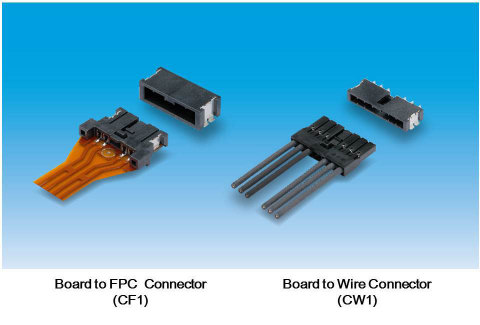OSAKA, Japan--(BUSINESS WIRE)--Panasonic Corporation announced that it has developed connectors for connecting in-vehicle LED lamp modules to control boards. These connectors improve in designing in-vehicle LED lighting.
One of these is a "Board to FPC Connector", the first of its kind in the
industry*1 that is suitable for cable connection to daytime
running lights (DRLs), which are kept switched on during the daytime,
and in rear lamps.
The other is a "Board to Wire Connector", the
lowest-profile connector in the industry*2 that is suitable
for LED headlamp modules.
|
These new products have the following features: |
|||
| [Board to FPC Connector] | |||
| 1. | This connector has a metal terminal connection structure that eliminates the need for FPC contacts for the first time in the industry*1, realizing direct connection between the LED-chip-mounted FPC and the control power board. It requires no relay harness, allowing the use of fewer components and fewer man-hours. | ||
| 2. |
The connector's double-clip structure ensures its resistance to vibration and temperatures up to 125 degrees Celsius, both extremely desirable properties for headlamps. |
||
| [Board to Wire Connector] | |||
| 1. | This connector has an in-house-developed terminal shape that gives the connector a height of only 3.4 mm, the lowest profile of any connector in the industry*2. This low profile connector exerts a minimal effect on the lighting angle of the LED, enabling smaller and low profile LED lamp modules to be easily manufactured. | ||
| 2. |
The connector's unique LED headlamp terminal structure gives it vital vibration resistance as well as heat resistance up to 125 degrees Celsius. |
||
| *1: | On June 8, 2016, it was developed as a two-piece type board to FPC connector (according to research by Panasonic). | ||
| *2: | On June 8, 2016, it was developed as a connector for in-vehicle LED lamp modules (according to research by Panasonic). | ||
About Panasonic
Panasonic
Corporation is a worldwide leader in the development of diverse
electronics technologies and solutions for customers in the consumer
electronics, housing, automotive, enterprise solutions and device
industries. Since its founding in 1918, the company has expanded
globally and now operates 474 subsidiaries and 94 associated companies
worldwide, recording consolidated net sales of 7.553 trillion yen for
the year ended March 31, 2016. Committed to pursuing new value through
innovation across divisional lines, the company uses its technologies to
create a better life and a better world for its customers. To learn more
about Panasonic: http://www.panasonic.com/global.




